Can you really achieve SEO results in just 3 months? The answer is yes.
While long-term strategies deliver the full impact over years, a focused 90-day plan can dramatically improve your search rankings and traffic with thousands of new visitors.
If you don’t believe you can achieve thousands of new visitors in 3 months, just look at the cases further down.
This guide breaks down exactly how to structure your SEO campaign, from technical audits to content creation and link building, to set your website on the path to success.
What is a 3-month SEO plan?
A 3-month SEO plan is a focused, short-term strategy designed to improve your website’s search engine rankings and drive organic traffic.
While SEO is often viewed as a long-term investment, a carefully executed 90-day roadmap can yield noticeable improvements much faster. By addressing critical issues such as technical errors and content gaps, you can create a solid foundation that not only enhances your current performance but also sets the stage for long-term success.
This approach involves a process that includes technical audits which can be easily done with our SEO checker, content optimization, and off-page strategies, all tailored to achieve specific, measurable goals.
This strategic plan is particularly useful if you’re looking to validate the impact of SEO on your website quickly. It can also serve as a proof-of-concept to demonstrate progress, even if you plan to expand your efforts over a longer period later on.
Top benefits of a 90-day SEO campaign

Getting started on a 90-day SEO campaign comes with a number of benefits that can significantly impact your business.
One of the primary advantages is the opportunity to achieve quick wins. Addressing issues such as slow page load times or outdated content can lead to immediate improvements in user experience and engagement. When users notice that your site is fast and informative, it not only increases the likelihood of conversions but also sends positive signals to search engines.
Another key benefit is the establishment of clear milestones. When you break down your strategy into a series of phases, each with its own set of objectives, you gain clarity and focus. Such structured approach helps you tackle both technical issues and content gaps methodically instead of randomly.
It also provides a way to track progress over time, so you can see how each improvement contributes to the overall growth of your site.
As you move through your campaign, you may find that setting measurable, SMART goals (for example, aiming for a specific percentage increase in organic traffic) becomes invaluable for guiding your efforts and evaluating success.
Yet another advantage of a short-term plan is that it lays the groundwork for long-term success. By resolving high-impact issues and creating a content strategy, your website is well-prepared for more extensive optimization in the future.
However, it’s important to recognize that while the initial results can be very encouraging, ongoing efforts will be necessary to maintain and build upon these gains.
In summary:
- Rapid improvements: Increasing page speed, mobile compatibility, and user experience can lead to immediate ranking gains.
- Clear milestones: A structured plan with specific objectives helps you track progress and adjust strategies as needed.
- Foundation for growth: The groundwork laid in 90 days provides a sustainable base for further SEO enhancements.
Potential risks of a rapid SEO campaign and considerations
Every SEO campaign carries some risk, and a rapid 90-day strategy is no exception. One possible challenge is the risk of incomplete implementation.
In the rush to achieve quick results, there may be a temptation to skip over in-depth technical audits or detailed content updates that seems less important, which can lead to missed opportunities or unresolved issues.
It’s also important to acknowledge that SEO is inherently a long-term process. While you may see early gains, these results should be viewed as the beginning of your journey rather than the full potential of your SEO efforts.
Resource allocation can also be a concern. With limited time and manpower, it might be necessary to prioritize certain tasks over others. This could mean that some parts, such as link building strategies, may need to be introduced gradually rather than all at once.
Moreover, the amount of data from analytics tools might lead to over-analysis and unnecessary stress. It is beneficial to focus on broader trends rather than day-to-day fluctuations, which can sometimes be misleading.
In summary:
- Incomplete implementation:
Rushing through audits or updates may leave some technical issues unresolved. It’s important to strike a balance between speed and thoroughness. - Resource constraints:
With limited time and manpower, you might need to prioritize high-impact tasks over more advanced techniques like intricate link-building campaigns. - Data overload:
Monitoring too many metrics on a daily basis can be overwhelming. Focus on weekly or bi-weekly trends instead of reacting to daily fluctuations.
The challenges raise important questions: How much is too much when it comes to short-term SEO efforts? And, how can you balance immediate improvements with long-term sustainability?
Addressing these considerations thoughtfully will help you navigate potential pitfalls and optimize your approach effectively.
My personal experience with a 3-month SEO plan
Based on my own journey, the 90-day plan can be transformative when implemented with care. In my experience, dedicating the first month to technical improvements and content audits is important for the upcoming work.
I found that addressing issues like broken links, slow load times, and mobile optimization significantly boosts both user engagement and search engine performance.
In the second month, I shift focus to refining on-page elements and creating fresh, keyword-rich, and user-centric content covering questions, concerns, comparisons, buyer guides and of course category- and service pages. This phase is about experimenting and learning what resonates best with your audience.
The final month I dedicate to off-page SEO. Building high-quality backlinks through guest posts, outreach, and even paid links, along with active engagement on social media, helps increase the site’s authority.
The 3-month process is what I implement personally for price sensitive customers with small budgets and for larger projects as the initial proof of concept before longer partnerships is agreed.
The 3-month plan can also be a repetitive task to work with SEO in 3-month sprints and is not only meant for small businesses or initial proof of concept for your boss. To use the 3-month framework as sprints, you should focus on certain categories or subjects on your website for each sprint to thoroughly optimize your entire online universe.
Are you yet to be convinced that SEO results can be achieved in just 3 months? Let’s look at a few real world cases (these can be shown to your boss too to get the resources to get started).
3 month SEO examples (real cases)
Can it really be true? In just 90 days?
Yes, it can. here is the proof.
Example 1: Fenerum.com
Fenerum reached +100% of organic growth in just 3 months from the beginning of november 2024 to the beginning of february 2025. From approximately 500 monthly clicks to +1.100 monthly clicks. Pretty good growth in 3 months, right?
Read the full Fenerum case here.
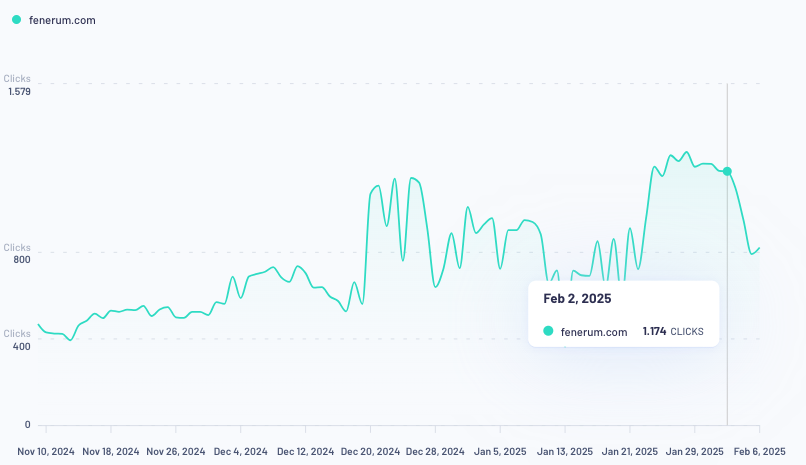
Example 2: Pulsure.dk
Pulsure is just another example of how much organic traffic growth you can achieve in just 3 months. They increased traffic from 78.000 monthly visitors to 90.000 monthly visitors from February 21st 2024 to May 21st 2024.
As the growth graph shows, the first 3 months should be the initial step of a full blown SEO project as traffic keeps increasing month after month if you keep the habits.
Read the full Pulsure case here.
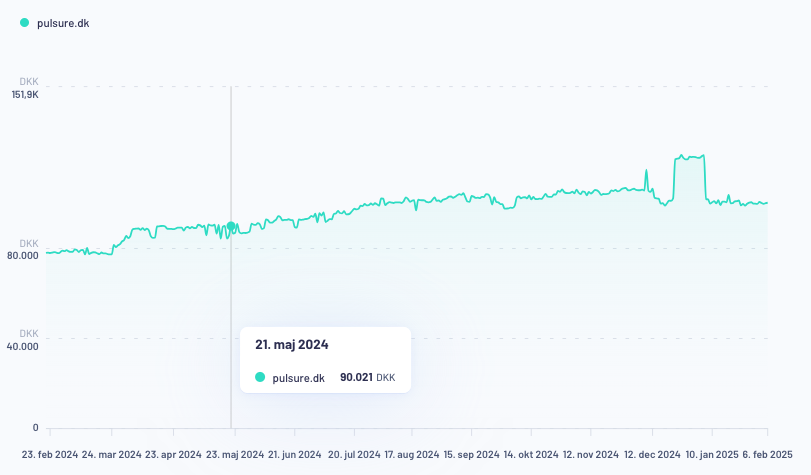
Example 3: Shopnordthy.com
Nordthy’s webshop, called Shopnordthy, rapidly increased traffic from 8.000 monthly organic visitors to 19.000 – as you probably guessed, it took only 3 months to get there.
From April 1st 2024 to July 1st 2024 they more than doubled the organic traffic to their webshop. Impressive!
Read the full Shopnordthy case here.
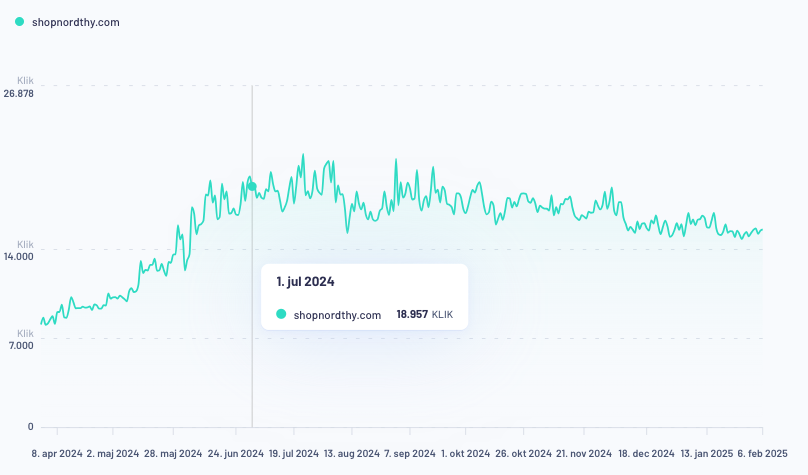
This is just 3 examples and there is so much more cases showing the exact same thing coming up. Are you going to be the next one worth talking about?
Kick off a 3 month SEO project, nail it and reach out to me to get a dedicated landing page on Morningscore highlighting your results too.
Oh, and you will also get a backlink from Morningscore in return. Check out other similar customer cases here.
Convinced yet?
If not, well, you are missing out on leads, customers, and branding. Your competitors are growing stronger day by day, and the longer you wait the bigger competition you will face.
What do experts have to say?
I spoke to Christian Aalykke, Head of Customer Success at Morningscore, SEO course instructor and speaker at Ignite 2024 in Odense, Denmark, to get his opinion about 3-month SEO projects.
Here is what he had to say:
My overall contention is that anybody can become comfortable with SEO and produce tangible results in a matter of weeks.
But let’s not jump the gun here.Going into SEO for the first time, you need to adjust your mindset. Results from SEO do simply not happen overnight.
Becoming comfortable with SEO, however, is the number one prerequisite for producing results.
How to become comfortable with SEO and produce results in a matter of 3 months then?
A: Learn what users need.
B: Convert that knowledge into content.
The 90-day SEO roadmap: A step-by-step guide
Let’s look into the details of the roadmap for each month.
Month 1: Lay the foundation
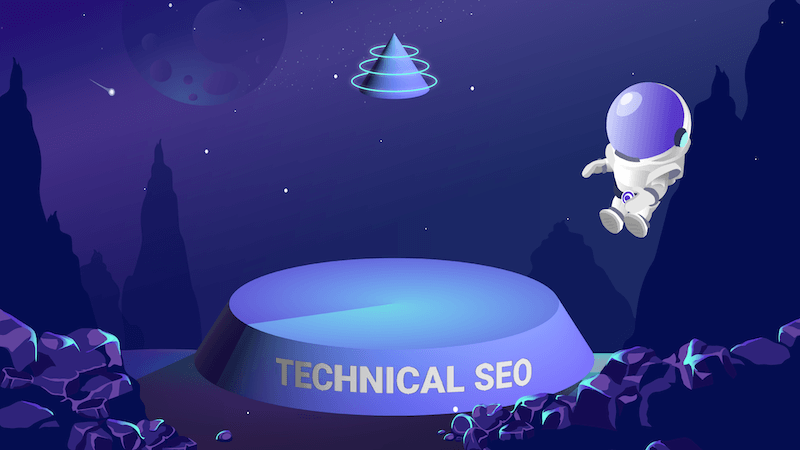
Focus on building a solid technical and content foundation that supports all future SEO efforts.
Technical SEO fixes
- Optimize site structure:
Create a logical hierarchy of categories and subcategories for easy navigation by users and search engines. - Improve page speed:
Compress images (using tools like TinyPNG), enable browser caching, and minimize CSS/JS files.
(Tip: Use a reliable CMS such as WordPress or Shopify on a powerful server, and avoid excessive plugins that slow down your site.)
Initial on-page optimization
- Title tags & meta descriptions:
- Include primary keywords early.
- Write compelling copy to boost click-through rates (CTRs).
- Headers:
- Use a single H1 for the main topic.
- Utilize H2s and H3s for subtopics, incorporating primary and related keywords naturally.
- Keyword placement:
Make key terms appear within the first 100 words for early relevance (above the fold).
Content enhancement
- Quick wins:
Target low-competition, long-tail keywords that match user intent. - Refreshing existing content:
Update statistics, reformat for clarity, and add fresh insights.
By the end of Month 1, expect improvements in user experience, page speed, and initial ranking shifts for targeted keywords.
Tip: Check out all the elements you need to cover in your SEO strategy here.
Month 2: accelerate your on-page SEO
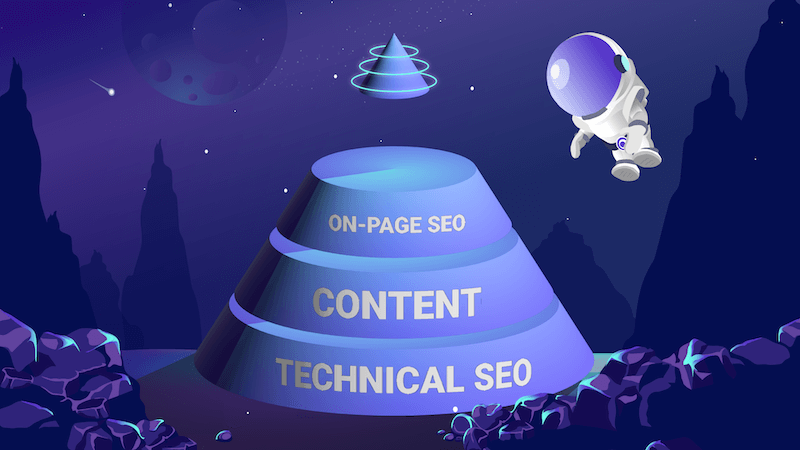
With the groundwork in place, month 2 is all about enhancing your content and user experience.
Content creation & refresh strategy
- Publish new content:
Aim for 2–3 new landing pages or blog posts per week.- Focus: A mix of “money keywords” (directly linked to your products or services) and inspirational guides or symptom searches.
- Update existing content:
Refresh pages with new sections, headers, visuals, and updated statistics.
Enhance user experience (UX) & mobile friendliness
- Mobile optimization:
Ensure text is readable, and buttons or links are easy to tap on mobile devices. - Clean navigation:
Reduce clutter and design intuitive layouts with clear calls-to-action.
Build internal links & topic clusters
- Logical linking:
Connect newer articles to authoritative older posts. - Pillar pages:
Create comprehensive content clusters around core topics and link related cluster articles to add depth.
Effective on-page enhancements in month 2 will not only improve rankings but also boost user engagement and time on site.
Tip: Check out all on-page SEO elements here to optimize each of your pages.
Month 3: Boost authority with off-page SEO
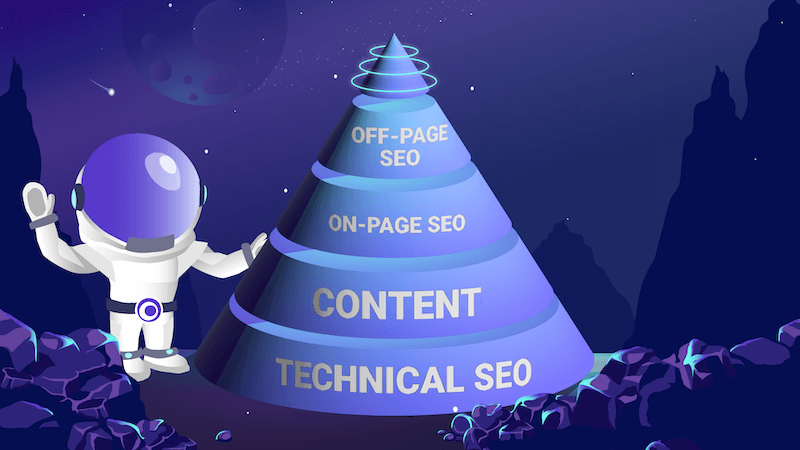
The final month is dedicated to establishing your website’s authority through off-page SEO techniques.
Link building & outreach
- Guest posting:
Reach out to reputable sites in your niche for guest posting opportunities, including backlinks to your content. - Resource link pages:
Identify and target industry resource pages for link placements. - Broken link building:
Find broken links on authoritative sites and suggest your content as a valuable replacement.
Amplify social signals & community engagement
- Social media promotion:
Share your newly optimized content across platforms to drive engagement and traffic. - Engage in forums & Q&A sites:
Contribute to communities like Quora, Reddit, or niche-specific forums—linking back to your site when relevant.
Leverage brand mentions & PR
- Local SEO:
Build strong local SEO by getting listed in local directories and encourage reviews on platforms like Google Business Profile and monitor your local rankings if you offer local services. - Media outreach:
Create and distribute press releases or stories that attract media attention and build brand authority.
Download the 3 month SEO checklist here (no signup required).
Taking the next step
If you’re ready to get started with your 3 month SEO sprint, start by doing a comprehensive SEO audit to establish your current position. Reflect on your objectives and define clear, measurable goals—for instance, aiming for a specific percentage increase in organic traffic.
What a realistic goal is in terms of percentages depends on your current position as well as the amount of allocated resources.
As you move through the roadmap, maintain a balance between quick fixes and long-term strategies, and remain adaptable based on what your data reveals.
Remember, the success of your 90-day SEO plan depends on your commitment to continuous improvement. Regularly review your progress, adjust your tactics, and keep your focus on both immediate gains and sustainable growth.
Commitment is everything. If you don’t allocate the manpower to put in a serious effort for 3 months, you will likely not see the changes you hope for.
Take advantage of AI
AI is the talk of the town and personally, I dislike all the AI-hype that is going on at the moment as a lot of it is guesswork, dooms-day prophecies, false “LLMs is taking over Search”-claims, etc. because most SEOs and marketing people lives in a bubble with likeminded sensationalists (the “shiny new object” syndrome).
Nonetheless, AI chatbots does have its rights and, if used correct, can be a huge advantage in SEO. But you shouldn’t ask any chatbot to simply output a text a bout a subject and copy/paste it to your website. That kind of AI-generated content is full of AI fluff, generic, passive, plain boring text.
To help you maximize your output of your SEO efforts, I’ve made a few post with ChatGPT prompts that can help you in all aspects; finding and mapping keywords, creating content without AI fluff, analyzing and fixing on-page elements as well as find link building opportunities.
Here’s some helpful links to explore to get my favorite ChatGPT prompts:
- ChatGPT keyword research
- ChatGPT content creation
- ChatGPT on-page optimization
- ChatGPT link building
Final words
SEO isn’t rocket science. It’s about consistent, strategic effort. By following this 90-day SEO plan, you’re not just chasing short-term gains; you’re establishing a foundation for long-term success.
Adjust your tactics based on data, stay committed, and watch your rankings climb.
Ready to get started and see tangible results?
Common questions about the 3 month SEO plan
Can I really see results in just three months?
Yes, but the extent of those results varies based on your niche, competition level, and current site health. Getting results with SEO in just 3 months is possible for anyone, but the results and performing will get to even higher levels by continuing after 3 months as the full “effect” normally requires from 9 months of targeted work.
How should I prioritize tasks when I have limited time and resources?
Focus on high-impact activities first. On-page factors yields the best results as a stand-alone effort, but the technical foundation can drag down your general performance if you have issues. Gradually scale your efforts into off-page strategies.
What should I do after the 3-month SEO plan ends?
You’ll likely continue the core best practices while exploring more advanced tactics (e.g., more complex link building, content expansion). SEO is an ongoing process that benefits from consistent effort. Keep building 2-3 new landing pages or blog posts a week, link related pages together and increase authority on an ongoing basis by getting more backlinks, brand mentions, social activity and media coverage.

